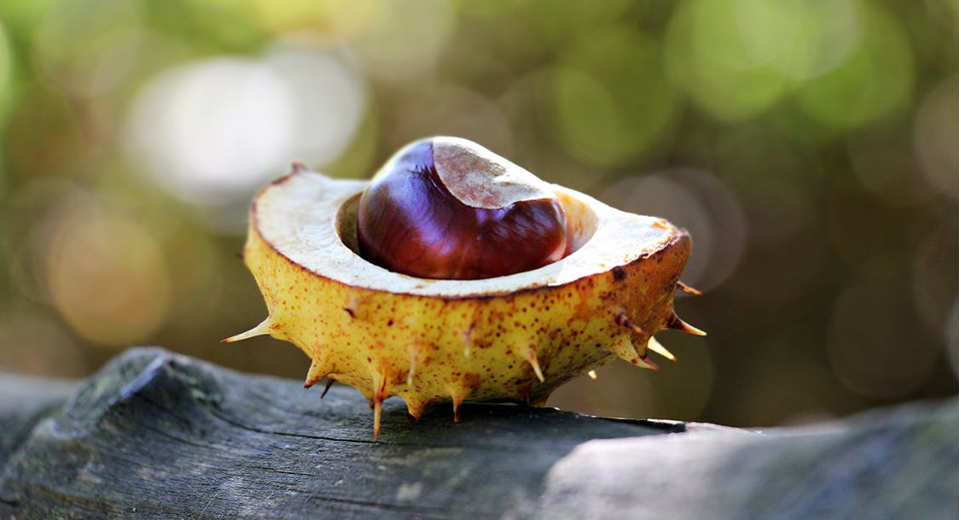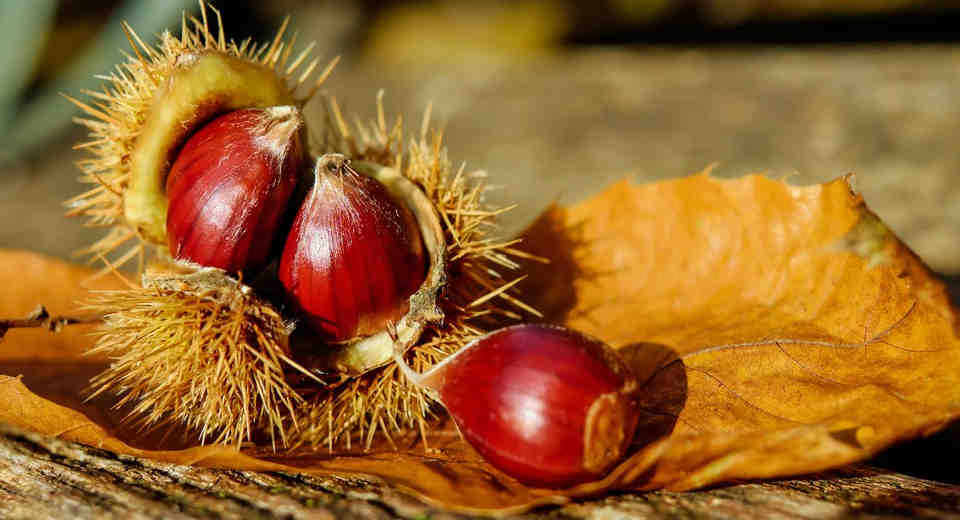Autumn is the most beautiful season for all collectors! But how to harvest chestnuts and prepare them the best? To collect sweet chestnuts you need only an airy basket and a little know how..
Roasted sweet chestnuts smell like heaven on earth. What hardly anyone knows: from the delicious sweet chestnuts you can also make gluten-free flour itself, for example, for bread, waffles, pancakes and cakes. Chestnut flour gives baked goods a delicious, nutty flavor.
The sweet chestnut used to be the bread tree of the poor – today it is valued more than ever as a gluten-free, healthy superfood that is also rich in alkaline micronutrients. Sweet chestnuts contain a lot of starch and are therefore very nutritious – they also contain potassium, magnesium, phosphorus, folic acid and C and B vitamins. It is considered a delicacy is experiencing its entry into the star cuisine. Glazed with roast goose or added to sauces or purees. I like them best roasted in the oven as a healthy nibble.
When the leaves turn autumnal, regionally different and depending on the variety from about September to November, the season for collecting sweet chestnuts begins.
Sweet chestnuts grow most frequently in the forests of southwestern Germany. It is worth keeping your eyes open in the cities, because there you can discover sweet chestnut trees in surprising places – for example, very close to Alexanderplatz in Berlin!
You can only confuse sweet chestnuts with the horse chestnut – but if you pay attention to the characteristics listed here on the tree and the chestnut, they are easy to distinguish. Unfortunately, the horse chestnut is slightly poisonous, chestnut chestnut is chestnut chestnut is slightly poisonous, chestnut chestnut tastes bitter, and it is inedible. Therefore, especially children should definitely be taught the difference between horse chestnut and sweet chestnut.
Interesting: Only sweet chestnut cultivars with up to three large fruits are strictly speaking maroons – several smaller fruits bear sweet chestnut trees – of which there are about 20 different varieties in Germany. The less inner skin is grown into the fruit, the higher quality it is. Sweet chestnut trees can reach a stately age of several hundred years and grow up to 30 m high.
1. How to Distinguish Horse Chestnut and Sweet Chestnut

You can make pretty little men and animals out of horse chestnuts – but they are not edible! They taste bitter and can upset your stomach.
The sweet chestnuts that grow in Germany are actually sweet chestnuts – an even more aromatic and higher quality variety of sweet chestnut. While the core of the chestnut is heart-shaped and has a shell with a triangular bottom, the sweet chestnuts are round, smaller and less intense in flavor.

When collecting sweet chestnuts, you can recognize sweet chestnut and horse chestnut by these features:
Different Leaf Shapes
The leaves of horse chestnuts consist of several finger-shaped leaves of juicy green leaves that converge with a very long stem. Sweet chestnut leaves are single, serrated and shaped like a lance.
Fruit Capsules with Various Spines
The fruit capsules of horse chestnuts have room for only one fruit, are thick-fleshed and studded with solitary spines. The fruit capsule of the delicious sweet chestnuts contains several fruits and is densely covered with finer, longer spines.
Different Fruit Shape
The rusty brown horse chestnuts are round or oval. In contrast, sweet chestnuts are flat on one side, taper to a point, and are hairy at the tip. Inside the shell sits a fruit enclosed by a skin.
2. Sweet Chestnuts Crack Without Pricking
The prickly chestnuts usually lie in the foliage still closed by the husk. The spines prick and opening the prickly shell with bare hands is not recommended. Either use your shoe for cracking and carefully step on the shell with the hoe until it opens. The chestnuts will then fall out and you can pick them up. Or simply wear gardening gloves made of sturdy fabric – preferably ones that are thorn-proof.
3. How to Harvest Chestnuts and Let Them Ripen
You don’t harvest sweet chestnuts from the tree. When the fruits are ripe, the fruits surrounded by a spiny husk fall to the ground. The fruits are ripe when the husk is completely dark brown in color. If sweet chestnuts still have white spots, it is best to simply wrap them in newspaper and let them ripen in a dry, warm place.
When collecting sweet chestnuts, the fruit should not have been in wet grass for more than 2 or 3 days. Otherwise there is a risk of mold or worm infestation! Only collect intact fruits.
Do not put the collected chestnuts in plastic bags but in airy wicker baskets or wire baskets (e.g. a bicycle basket). This way they get air and can be stored longer.
4. Store Chestnuts – Shelf Life
Rub the collected chestnuts dry with a tea towel and spread them loosely on newspaper. Sort out eating chestnuts with worm holes. Cover with newspaper and store in a cool, damp place – the potato cellar is ideal. This way the chestnuts will keep for 4-6 weeks!
An air-permeable potato storage box is also good.
5. Prepare Sweet Chestnuts – Roasting or Boiling
Sweet chestnuts can also be eaten raw! They taste sweet and nutty. However, roasted or boiled they become softer and have a consistency like boiled potatoes, are also more aromatic and digestible in my opinion. The chestnuts should be peeled while they are still hot and not quenched! Because the cooler the chestnut the more firmly the skin and shell adhere to the core again.
Collecting and Roasting Sweet Chestnuts
Roasting chestnuts is the simplest and, in my opinion, still the most delicious way to prepare sweet chestnuts. To do this, take a serrated knife and cut a cross into the chestnut on the flat side.
Then spread baking paper on a baking tray, place the chestnuts on it and roast them in the oven at 200 degrees for about 20 minutes, depending on their size. You can smell it immediately when they are ready! The delicious scent of chestnuts is in the air and the shell is crispy lightly browned and cracked and easy to peel off once the chestnuts have cooled.
Cook the Chestnuts
Cut the chestnuts again in a cross shape with a knife or a chestnut carver. Then boil in salted water for 20 minutes and peel while hot.
The question now is not: how to harvest chestnuts but when do I go out to collect them? 🙂 In addition to collecting chestnuts, other delicacies lure you into the forest: porcini mushrooms, chanterelles, and other delicious hat-bearers! At Greatime, you’ll find my forest mushroom recipes and my 11 tips for mushroom hunting that everyone who goes mushrooming should know.
You should check out these autumn activities! For every season, you’ll find inspiration for gifts and activities with kids, friends, and your partner on Greatime. Check it out. You will also find us on Facebook and Instagram!
*There are affiliate links in this article. This means that if you order a product through one of these links, Greatime may receive a small commission without costing the buyer more.

![How To Harvest Chestnuts And Prepare Them 5 Essential Tips [Uber En="This*is*how*to*harvest*chestnuts*-*the*best*place*to*collect*chestnuts*is*in*south-west*Germany." De="Esskastanien*sammeln*kann*man*am*besten*in*Südwestdeutschland"]](https://greatime.de/wp-content/uploads/2018/09/esskastanien-sammeln-gehen.jpg)
![Uber En Quot Puzzle Advent Calendar Quot De Quot R Tsel Adventskalender Quot [Uber En="DIY*Puzzle*Advent*calendar*make*yourself*with*beautiful*puzzle*cards" De="Rätsel*Adventskalender*selber*machen*mit*schönen*Rätselkarten"]](https://greatime.de/wp-content/uploads/2023/11/raetsel-adventskalender-selber-machen-tutorial.jpg)
![Uber En Quot Advent Calendar In A Jar Quot De Quot Adventskalender Im Glas Quot [Uber En="An*Advent*calendar*in*a*jar*can*be*made*even*last*minute" De="Adventskalender*im*Glas*kann*man*als*Adventskalender*selber*machen*ohne*viel*Zeit*zu*brauchen"]](https://greatime.de/wp-content/uploads/2017/11/adventskalender-im-glas-adventskalender-selber-machen.jpg)
![Uber En Quot Potato Soups Quot De Quot Kartoffelsuppen Quot [Uber En="The*best*potato*soup*recipes" De="Kartoffelsuppe*gibt*es*in*vielen*Variationen"]](https://greatime.de/wp-content/uploads/2016/11/kartoffelsuppe-challenge.jpg)